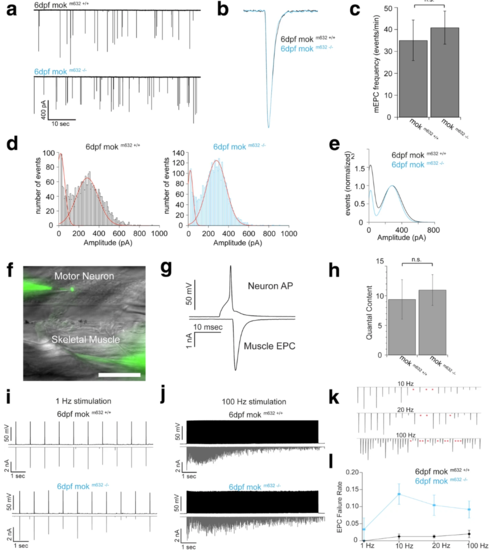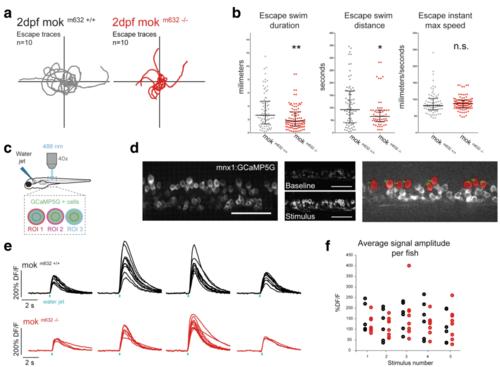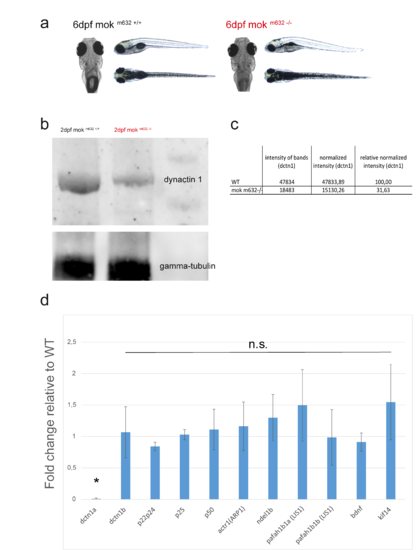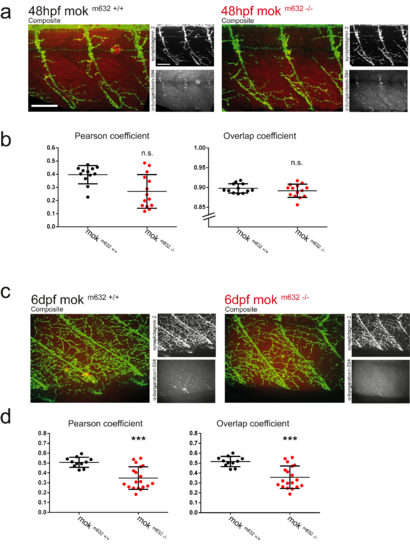- Title
-
Dynactin1 depletion leads to neuromuscular synapse instability and functional abnormalities
- Authors
- Bercier, V., Hubbard, J.M., Fidelin, K., Duroure, K., Auer, T.O., Revenu, C., Wyart, C., Del Bene, F.
- Source
- Full text @ Mol. Neurodegener.

ZFIN is incorporating published figure images and captions as part of an ongoing project. Figures from some publications have not yet been curated, or are not available for display because of copyright restrictions. |

ZFIN is incorporating published figure images and captions as part of an ongoing project. Figures from some publications have not yet been curated, or are not available for display because of copyright restrictions. |

ZFIN is incorporating published figure images and captions as part of an ongoing project. Figures from some publications have not yet been curated, or are not available for display because of copyright restrictions. PHENOTYPE:
|
|
NMJ function is impaired by severely reduced levels of Dynactin1a. a Sample traces of spontaneous miniature end plate currents (mEPCs) from fast-twitch muscle fibers. b Normalized individual mEPCs from mok m632−/− larvae (blue trace) and their wild-type siblings (black trace). c Average mEPC frequency recorded from wild-type and mutant mok m632−/− larvae. dmEPC amplitude histogram for wild-type and mok m632−/− larvae with Gaussian functions (red traces). e Normalized Gaussian fits from wild-type (black trace) and mok m632−/− larvae (blue trace). f Paired motor neuron skeletal muscle fiber recording each patched and filled with AlexaFluor 488 (calibration bar = 100um). g Motor neuron action potential is evoked by a 2 msec current injection (upper trace) and subsequent muscle EPC is recorded (lower trace). h Average quantal content (evoked EPC amplitude/mEPC amplitude for wild-type and mok m632−/− larvae. Sample traces from paired neuron – muscle whole cell recordings for wild-type and mok m632−/− larvae with stimulus frequencies of i 1 Hz and j 100 Hz. k Magnification of evoked EPCs from mok m632−/− larvae recordings demonstrating postsynaptic EPC failures occurring at 10, 20 and 100 Hz (red asterisks). l Evoked EPC failure rate is significantly higher in mok m632−/− (blue trace) than in wild-type larvae (black trace) for paired recordings 10 Hz, 20 Hz and 100 Hz. Data shown as mean +/−SEM. (c: average = 35.04 ± 9.25, n = 2638 events from 15 fish/ average = 40.86 ± 7.53, n = 4903 events from 24 fish; d: n = 2638 events from 15 fish/ n = 4903 events from 24 fish; d: WT peak 1 average = 18.35, WT peak 2 average = 283.19, mutant peak 1 average = 20.42, mutant peak 2 average = 280.00; h: QC = 9.39 ± 3.31, n = 8 pairs/ QC = 10.98 ± 2.59, n = 18 pairs; l: n = 8 pairs/ n = 9 pairs) PHENOTYPE:
|
|
NMJ dysfunction leads to behavioral deficits. a NMJ functional defects lead to impaired locomotor behavior in 2dpf embryos as determined by touch-evoked escape response assay. Escape traces extracted from video tracking of escape swimming episodes following the presentation of a stimulus for 10 embryos per genotype shown here as an example. bQuantification of escapes reveal that Dynactin1a depletion leads to impaired locomotion determined by reduced escape duration and distance, but without altering maximum instant speed. c Calcium imaging of fictive escape responses in motor neurons expressing GCaMP5 was performed in the spinal cord upon presentation of a water jet stimulus. d GCaMP5 expression was confined to motor neurons and analysis of calcium signals was performed on dorsally-located primary motor neurons (region of interest in red). e Example of calcium signals obtained from primary motor neurons including CaP motor neurons in mok m632−/−larvae (red) and their wild-type siblings (black) at 4dpf; one trace per cell, four fictive escape responses are represented to show response variability. f Maximum DF/F amplitude signal in dorsal motor neurons averaged per fish and plotted according to the stimulation number, showing proper recruitment of spinal cord motor neurons despite reduced levels of Dynactin1a. Data shown as b) median +/− interquartile range (b: n = 76,101; f: n embryos/n cells = 6/63, 8/44) Scale bar 100 μm PHENOTYPE:
|
|
mok m632−/− embryo morphology at 6dpf, Dynactin1 protein quantification at 2dpf and qRT-PCR expression in mok m632−/− larvae. a) Wild-type sibling and homozygous mutant embryo morphology at 6dpf; close-up showing a dorsal view of the head to emphasize previously described eye phenotype. b) Western blot of maternally-contributed Dynactin1 in 2dpf mok m632−/− embryo (detected with anti-DCTN1 antibody from Origene, TA346929), c) quantified against gamma-tubulin at 32% wild-type level. d) Quantification of 3 biological replicates of qRT-PCR levels from 6dpf mok m632−/− larvae mRNA relative to the average wild-type levels obtained for 6dpf m632+/+ larvae mRNA (presented as fold change) shows no compensation by dynctin1b or kif14, no change in the expression of other subunits of the dynactin complex (p22/24, p25, p50, actr1), no change in other known regulators of the dynein motor complex (ndel1b, pafah1b1a/1b1b), and no changes indicative of trophic compensation (bdnf). (TIF 45716 kb) |
|
mok m632−/− embryo and larvae NMJ structural integrity. a) Double immunohistochemistry reveals the integrity of the NMJ at 2dpf by coverage and colocalization of presynaptic structures (anti-synaptotagmin2, in green) and postsynaptic Ach receptors (α-bungarotoxin, in red). b) Quantification of the colocalization shows normal NMJ structure of the ventral root at 2dpf by both Pearson’s coefficient and the overlap coefficient. c) NMJ structure is also affected at 6dpf, with d) reduced coverage in pre- and postsynaptic components, as well as reduced colocalization. All data presented as average +/− SD; (b: n embryos = 12, 14; d: n larvae = 11,19) (TIF 32575 kb) PHENOTYPE:
|

ZFIN is incorporating published figure images and captions as part of an ongoing project. Figures from some publications have not yet been curated, or are not available for display because of copyright restrictions. PHENOTYPE:
|

ZFIN is incorporating published figure images and captions as part of an ongoing project. Figures from some publications have not yet been curated, or are not available for display because of copyright restrictions. |




